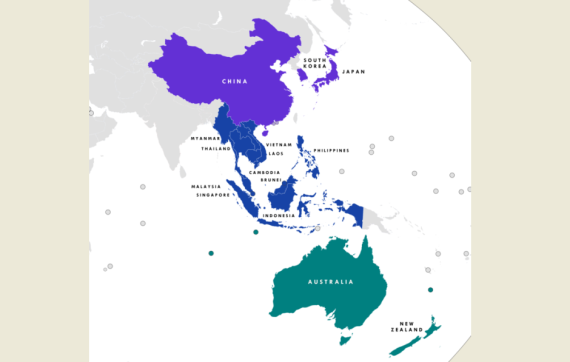- The Ministry of Commerce said the country is prepared to implement tariff reductions, adjustments in the rules of origin, and software system updates at customs authorities to ensure smooth tariff reductions under the RCEP framework
- The ministry and other government agencies have completed preparations needed to implement all 701 binding obligations involving China under the RCEP
- Six ASEAN member states and four non-ASEAN signatory states have so far ratified the mega free trade agreement
- China’s foreign trade volume with other RCEP participants surged 19.3% year-on-year in the first three quarters of this year
China says it is ready to lower its tariffs once the Asia-Pacific free trade deal Regional Comprehensive Economic Partnership Agreement (RCEP) takes effect at the start of 2022.
The Ministry of Commerce announced on November 7 that the country has completed all preparations needed to implement committed tariff reductions, adjustments in the rules of origin for goods, and software system updates at customs authorities to ensure smooth tariff reductions under the RCEP framework, reported Ecns.cn.
China will be able to fully meet its obligations when the RCEP comes into effect at the start of next year, stressed Yu Benlin, director-general of the ministry’s department of international trade and economic affairs.
In a separate statement, the ASEAN Secretariat said that as of November 2, six ASEAN member states—Brunei Darussalam, Cambodia, Laos, Singapore, Thailand, and Vietnam—as well as four non-ASEAN signatory states—Australia, China, Japan, and New Zealand—have ratified the mega trade pact.
The agreement provides that it will enter into force 60 days after at least six ASEAN member states and at least three non-ASEAN member states have ratified it. This means the FTA shall enter into force on January 1, 2022.
The other members of RCEP are Indonesia, Malaysia, Myanmar, the Philippines, and South Korea.
With the RCEP in place, ASEAN members could be able to expand their list of duty-free products from China to include automobiles and parts, motorcycles, chemicals, electromechanical products, and steel products.
The RCEP is a modern and comprehensive free trade agreement that covers trade in goods, trade in services, investment, economic and technical cooperation, and creates new rules for electronic commerce, intellectual property, government procurement, competition, and small and medium sized enterprises.
Yu said the RCEP, the world’s biggest trade pact by GDP, is designed to remove as much as 90% of the tariffs on goods traded between signatories within a decade of coming into effect. It is set to significantly boost trade and foster wider market access in finance, transportation, education and tourism services.
The Ministry of Commerce and other government agencies have completed preparations required to implement all 701 binding obligations involving China under the RCEP, Yu added.
A total of 166,000 Chinese entrepreneurs, trade and customs officials and related personnel have completed RCEP training in over 600 training sessions and online training courses.
The RCEP will further stabilize industrial and supply chains in the Asia-Pacific region when it comes into effect, ensure free trade and regional connectivity, and contribute to the world’s economic recovery, said Dang Yingjie, deputy director-general of the national office of port administration at the General Administration of Customs.
China’s foreign trade volume with other RCEP participants surged 19.3% year-on-year in the first three quarters of this year, data from the administration showed.
The RCEP was officially signed on November 15 last year. Its 15 member countries have a total population of 2.27 billion and a total GDP of US$26 trillion. Their combined exports stand at $5.2 trillion, accounting for around 30% of the world’s total economic output, data from the Ministry of Commerce showed.
Photo by Tiger 7253









